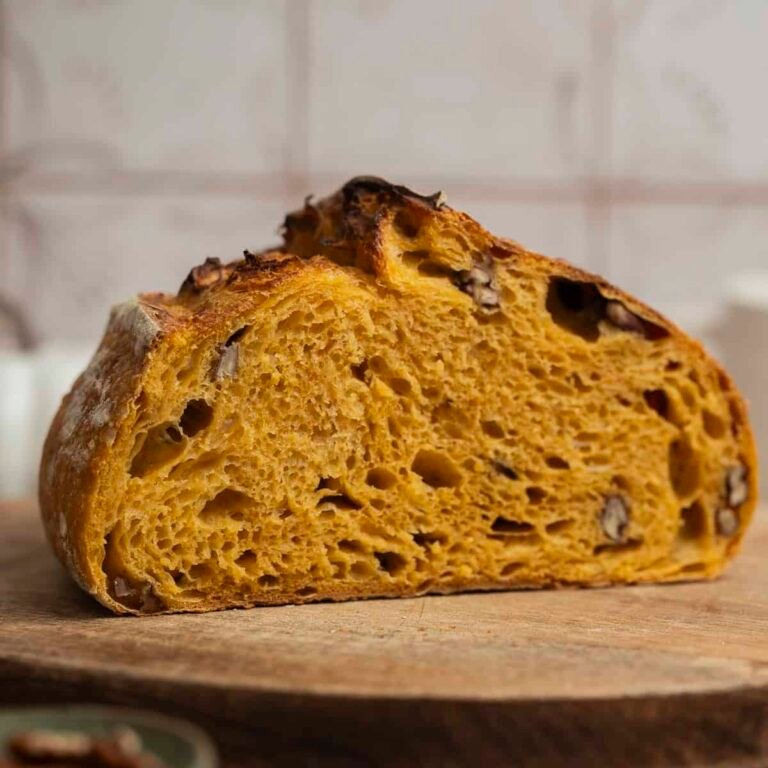This pumpkin sourdough bread is soft, golden, and gently sweet. The pumpkin puree gives the dough a beautiful color and soft crumb, while the sourdough adds flavor and chew. Dotted with crunchy pecans. This bread is perfect toasted with butter, spread with cinnamon cream cheese, or served with soup.

About this bread
It doesn’t really taste like pumpkin, but it does add a nice touch and soft texture. You can use either canned pumpkin puree or homemade roasted pumpkin. I love the combination of pumpkin and pecans, so I added them to bread as well. By lightly toasting it before adding it, the nutty flavor will stand out even more. Since no spices are added to this dough, the original flavor of pumpkin remains intact, expanding the range of ways you can eat it.


sourdough starter
This recipe requires an active sourdough starter. I usually make a levain specifically for bread. This will feed some of the starter to be used throughout the dough. If you want to use the main starter directly, that’s fine too. For the best launch and flavor, make sure it’s active and bubbly, not too acidic.
tools i use


Bakery schedule
You can tweak the timing to suit your schedule, but here’s a guide to the timeline I currently use when the kitchen warms up. That changes in the winter.
9am: Make the levain. 2pm: Mix the dough. 2pm to 5pm: Stretch and fold. 5pm to 7pm: Bulk fermentation continued. 7pm: Shape and refrigerate overnight. The next day: Bake bread.


method
First, feed your starter so it’s ready when you need it.


Mix flour, water, and pumpkin to autolyse.


Add starter and salt and mix well.


Perform stretches and folds every 30 minutes for the next 3 hours.


As the fold progresses, the fabric becomes stronger and stronger.
When stretching or folding, lightly wet your hands to prevent the dough from sticking. Lift one side of the dough, stretch it over the top, and fold it over to the other side. Turn the bowl a quarter turn and repeat on the next side. Continue until you have folded all four sides, then cover the bowl and let it rest until the next fold.
Repeat this process every 30 minutes for about 3 hours. At first, the dough will be soft and tear easily, but over time it will gain strength and elasticity.


Continue batch fermentation until the dough shows signs of activity and has risen by 50-70%.


Toast the pecans in a dry skillet and let cool.


Roll out the dough on a floured surface and add 1/2 of the pecans. Fold it into thirds like a letter.


Rotate the dough 90 degrees and add the remaining pecans.


Roll the dough into a log and tuck the edges.


Place the fabric in a floured basket, seam side up, and sew the length of the fabric together. Refrigerate overnight.


Place the dough on a parchment paper or Dutch oven and make a score.


Cover and cook uncovered until dark brown.
Just before baking, use a very sharp razor blade or glitter to score the surface of the dough. Hold the blade at a slight angle and make a confident blow at a depth of about 0.5 to 1 centimeter.
For open ears, make one long curved cut slightly away from the center. For round loaves, make a simple cross or straight cut in the center. Make sure to move quickly and cleanly to avoid dragging or tearing the fabric.




pumpkin sourdough bread
This pumpkin sourdough bread is soft, golden, and gently sweet. The pumpkin puree gives the dough a beautiful color and soft crumb, while the sourdough adds flavor and chew. Makes 1 loaf.
Levain
twenty five g sourdough starter50 g all-purpose flour50 g water
bread
460 g all-purpose flour Contains at least 11% protein180 g pumpkin puree240 g waterAll about Levain or about 100g active starter9 g salt70 g half of pecan nuts
Combine the starter ingredients in a bowl and stir until completely combined. Place in a clean jar and loosely cover. Leave it in a warm place until it doubles in size.
When the starter is almost finished fermenting, combine the flour, water, and pumpkin puree in a large mixing bowl. Use a fork or wooden spoon to mix, then use wet hands to fold into a fuzzy dough ball, making sure not to leave any flour particles behind. Cover the bowl and let it autodigest at room temperature until the starter is ready.
Add the starter and salt to the dough and press it all together with wet hands. Add some slaps and folds to incorporate it better and start developing the structure.
Over the next 3 hours, stretch and fold this dough every 30 minutes. Pull the dough up and place it on top, turn the bowl a quarter turn, and repeat. Do this on all sides and always do it with wet hands.
After folding, place the dough in a clean bowl and allow it to ferment for another 1-2 hours. There should be clear signs of activity in the dough, such as bubbles forming or the dough shaking when you shake the bowl. At room temperatures of around 24°C/75°F, the dough will take an additional 1-3 hours to complete, but in cooler temperatures it will take longer.
Meanwhile, toast the pecans in a dry skillet over medium heat until fragrant, 2 to 3 minutes. Let it cool and then coarsely chop it.
Shape the sourdough into batards or balls, depending on the basket you’re using.
To shape the batard:
Lightly flour the work surface and turn the dough over. Shape it into a round shape and let it rest for about 20 minutes.
Flip it over so the smooth side is facing down. Gently roll it out into a rectangle. Add half of the pecans.
Fold the top third down and the bottom third up like a brochure and rotate 90 degrees. Add remaining pecans.
Start at the short end and roll up into a log. Pull the dough toward you on the counter to create surface tension, then tuck in the sides.
Place seam side up on a floured banneton for final finishing.
Cover the dough with a kitchen towel and refrigerate for 8 to 24 hours.
baking
The next day, preheat your oven and Dutch oven to 450°F/230°C for at least 30 minutes, until heated through.
Remove the hot Dutch oven and coat the bottom well with flour. Remove the dough from the refrigerator and carefully remove it from the basket and place it in the Dutch oven. If baking in a large pot, it’s best to place the dough on a cookie sheet. In this way it can be lowered into the pot.
Make incisions in the dough using a razor blade or sharp knife.
Cover and bake for about 20 minutes. Remove the lid and bake uncovered for another 20 minutes, depending on your preference and oven. Some ovens operate at higher temperatures and require less time, while others require more time.
Let the sourdough cool for at least 2 hours before slicing.
calorie: 295kcalcarbohydrates: 50gprotein: 7gfat: 7gSaturated fat: 1gPolyunsaturated fats: 2gMonounsaturated fats: 4gsodium: 3mgpotassium: 104mgfiber: 3gsugar: 1gVitamin A: 5IUVitamin C: 0.1mgcalcium: 17mgiron: 3mg
Sharing is caring!


